
The distinctive profile and ergonomic design of Cantiere Ernesto Riva’s Vaporina built for the Hotel Il Sereno.
A ride in a water taxi on Lake Como, either taken out of necessity or convenience, is a pleasure in itself. Water taxis go far beyond their evident practicality by offering comfort (with added extras if requested) and inimitable style. Yet while the style of these boats has long been dominated by Venetian design, Lake Como is in the process of re-establishing its own brand of boat – the Vaporina – which retains all the appeal of stylistic travel but adds ergonomic design specifically adapted to our lake’s aquatic environment. These boats are all constructed by the Cantiere Ernesto Riva in their workshop at Maslianico.
Venetian Style
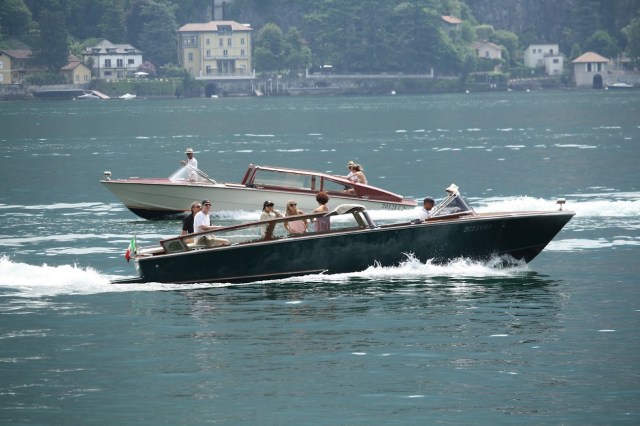
Two venetian-style water taxis cross paths in the waters off Laglio.
Venetian water taxis have developed iconic style status and have over the last eighty years have become more beautiful and ever more luxurious. Clearly Venice requires a fleet of efficient and comfortable water taxis given that the traditional gondola may well be the symbol of Venice itself but can hardly whisk you down the Grand Canal, over to the Lido or back to Marco Polo airport in time for tea. Venetian boatyards such as Serenella, Cucchini and Tagliapietra dominate the market and have gained international success by maintaining high standards of artisan craft and continual innovation.
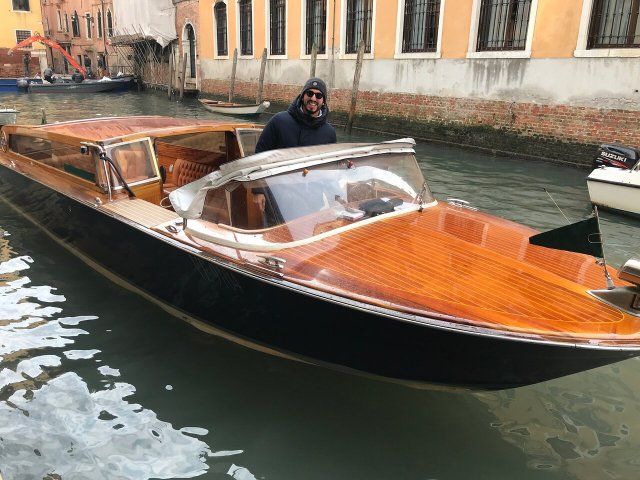
Sleek and stylish, the Venetian water taxi has become a symbol of La Serenissima
So it is no surprise that most of the water taxi companies operating on Lake Como also deploy these Venetian-style water taxis. The experience they offer the passenger is thrilling with the enclosed sleek deck-house giving shelter from rain or spray and the rear seating free for those who want to feel the fresh wind on the face, to have an unimpeded view of the lakeside or for gazing up onto a starlit sky. Yet, great as these boats are, they were designed for travel on canals and over the Venetian lagoon and not over the deep and sometimes choppy waters of Lake Como buffeted as it is by its two winds, the Breva and Tivano.
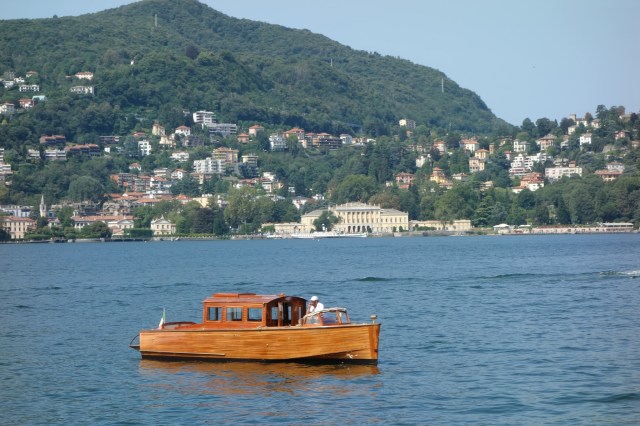
Vaporina takes time out with Como’s Villa Olmo in the background. The Vaporina’s profile is unique and readily identifiable when on the lake.
It was therefore only a question of time before one of the many long-established boatyards on Lake Como put their mind to designing a water taxi in line with local tradition and suited to local conditions. It was the oldest of the lake’s boatyards, Cantiere Ernesto Riva, who came up with the idea of redefining fin de siecle boats called Vaporine to modern needs and tastes.
The Vaporina’s Ancestors

Depiction of an early luxury gondola on Lake Como
Travellers by road around the Como leg of the lake in summer might appreciate how important or even preferable it can be to travel instead by boat. After all it wasn’t until 1876 when Torno, a very near neighbouring town, was actually connected by road to Como. Torno then had to wait until 1911 to have a road going north to Bellagio. Neither of these roads was tarmacked until the 1950s. Water taxis were then as much a necessity as a luxury. Wealthy residents could however afford to pay for the labour needed to power their own luxury boats which for most of their time remained moored as an adornment to the private docks in front of their lakeside villas.

The ‘Dulcinea’ now on display at the Museo Barca Lariana in Pianello del Lario. This boat, built by Cantiere Taroni in 1920 modified the traditional Inglesina design to allow for an early outboard motor although most were man-powered.
The most common form of man-powered water taxi in the 1800s was the ‘Inglesina’, so called due to its derivation from the pleasure boats deployed on the River Thames. Most of the boatyards on Lake Como built Inglesine either for private customers or to add to the fleet of boats used as taxis to ferry residents and visitors around the lake. The Inglesina Dulcinea was built in 1920 by the Cantiere Taroni in Carate Urio and on display at the Boat Museum in Pianello del Lario. (Cantiere Taroni are now based on Lake Maggiore in Stresa.) This hybrid model, designed to be either motor driven or man powered, shows some of the design origins of the Vaporina. However the original Vaporinas were, as their name suggests, steam powered and again it was the River Thames that provided the inspiration for Lake Como’s boat builders. One surviving example of an English ‘Vaporina’ is the Waterlily which was renovated back in 1977. It was constructed in 1866 by the Thornycroft Boatyards for the use of the Thornycroft family themselves and was converted from steam to a petrol motor in 1919.

Waterlily, built by Thornycroft in 1866. One of the first steam powered Thames launches.

Waterlily was renovated back in the 1970s and had her original steam engine re-installed. Steam engines were heavy, put strain on the boat’s wooden hulls and were of course also quite dirty.
Throughout the early twentieth century the basic shape of the Vaporina became the standard form for boats intended for a limited number of passengers. The Boat Museum in Pianello have a number of examples including the ‘Quo Vadiz’ built in 1925 by the Cantiere Taroni. This boat was originally located by Villa Carlotta in use as a water taxi for the general public. It later passed into the hands of Oscar Kiss Maerth, a textile tycoon who acquired Villa Passalacqua in Moltrasio in the 1970s. There he moored the ‘Quo Vadiz’ and an earlier Vaporina the ‘Lario’ also built by the Cantiere Taroni in 1903 and now also housed in the Pianello Museum. Villa Passalacqua has recently reopened as a super luxury hotel and will no doubt soon be commissioning its own Vaporina to transport its guests if only to keep up with its prestigious neighbour, the Hotel Villa D’Este in Cernobbio, which has a Vaporina built by the local Cranchi boatyard in 1960. None of these 20th century boats were powered by steam but the name Vaporina has stuck as identifying a particular style of boat of a certain dimension and common profile.
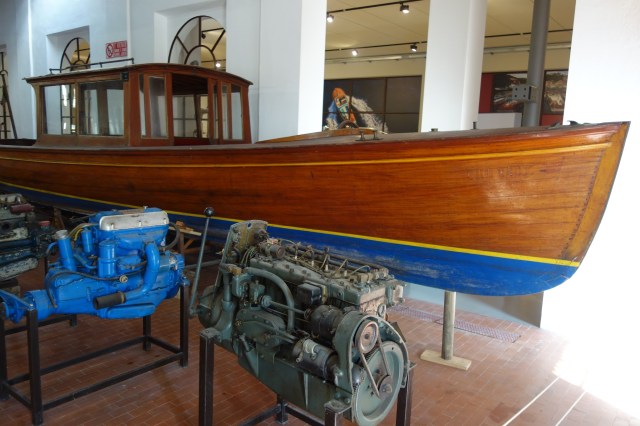
The ‘Quo Vadiz’ was built by Cantiere Taroni in 1925 and went into service as a water taxi near to Villa Carlotta. It then was purchased for use at Moltrasio’s Villa Passalacqua. It is now on display at the Museo Barca Lariana.
Cantiere Ernesto Riva
There is one boatyard on Lake Como, actually the oldest one, which has made a speciality of renovating and re-introducing Vaporinas on the lake. That is the Cantiere Ernesto Riva, established back in 1771 in Laglio where they still retain offices but with their main workshop now in Maslianico. Ernesto Riva restored the Vaporina Laura, built in 1908 and operated by Barindelli Taxi boats (a company still providing a water taxi and boat hire service in Bellagio) both for transporting tourists but also for assisting in the movement of contraband goods from Switzerland.
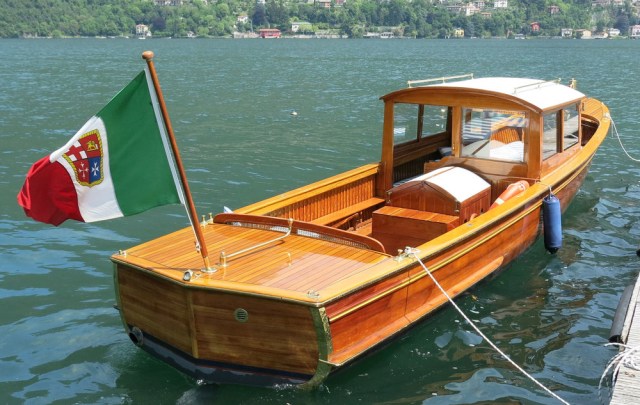
Cantiere Ernesto Riva renovated the Vaporina Laura
Looking at Laura, we can see the cockpit in the stern is similar to that of the Inglesina Dulcinea while the deck-house is derived from Waterlily which in turn is reminiscent of the luxury man-powered gondolas of the 18th century.

Cantiere Ernesta Riva completed renovation of the 1948 Vaporina Gandria back in 2013.
In 2013 the Ernesto Riva boatyard restored a larger Vaporina, the Gandria, constructed in 1948 and named after the town on Lake Lugano where it was in service. All of this recent experience meant the boatyard was more than qualified to take on a prestigious commission when approached by the owners of the Villa Pliniana in Torno. They wanted a water taxi for the use of their guests at the Villa Pliniana and for their nearby hotel then under construction, Il Sereno.
Como Style and Practicality – the New Vaporina

Staircase of the hotel Il Sereno whose interior and exterior were designed by Patricia Urquiola who also designed the interior of the Vaporina’s deck-house.
Il Sereno exudes luxury and style built using traditional materials of wood and stone but offering wide open vistas over lake and mountain. The interior and exterior design was entrusted to Patricia Urquiola who made best use of the hotel’s idyllic location. While the hotel’s design pays reference to the traditions of local construction, its design is uncompromisingly modern, So whilst we can readily appreciate the commissioning of a boat constructed out of wood by artisans like Cantiere Ernesto Riva, we might wonder why they approved a seemingly retro design. I believe they wished to retain all the past associations with the lake, particularly those of style and luxury, but to redefine them in a boat that applies the latest technology to ensure a practical and ergonomic design – a small reflection in part of the hotel’s own design brief. They wanted a boat (and a hotel) that could become as iconic of Lake Como as those sleek water taxis have become for Venice. It makes perfect sense that Patricia Urquiola should be asked to complete her brief by also designing the interior of the Vaporina’s deckhouse.

Professor Bertorello
Apart from the interior of the deckhouse, the Vaporina was designed by Professor Carlo Bertorello, a naval architect with more than 40 years experience who is currently an academic teaching and researching ship design at the Federico II University in Naples. A first glance at the boat’s profile shows it has more in common with Waterlily, Laura or Gandria than in any of the sleek Venetian launches. It stands taller, appears broader with its squared deck-house making an immediate visual impact. The wheelhouse is at the front, reminiscent of the early days of chauffeur-driven cars where the driver remained open to the elements. The cockpit at the back provides open air seating for guests.

This detail of the Vaporina’s prow shows the quality and beauty of the workmanship in wood – mahogany and Oregon cedar.
But its what cannot be seen that makes the Vaporina so innovative. Based on the studies of Professor Bertorello and the knowledge and expertise of the boatyard, the hull has been built slightly twisted so as best to cut through the typically short wavelengths found on our lake.
This adaption means the Vaporina does not require the same degree of power to drive it through the water as do other boats. It does so creating less spray with a reduced wake which makes the ride more comfortable and quiet. The comparison of the reduced wake and the calmer waves arriving to shore with those of a Venetian launch travelling at the same speed is remarkable and can only be good news for the environment.
The Vaporina may look a little retro but its ergonomic design creates less turbulence, is quieter and more energy efficient. As a result, although the original Vaporina was powered by diesel, they quickly went on to take advantage of the design’s ergonomic efficiency to build other models entirely powered by electricity – the Elettra.

Elettra – the latest Vaporina from Cantiere Ernesto Riva, entirely powered by electricity.
Further Innovation
A novelty this year for Il Sereno’s guests is to take a gourmet hamper prepared in the hotel’s kitchens for an outing on a newly-renovated Inglesina – also from the Ernesto Riva boatyard. Here is how the ‘Inglesina’ experience has been advertised:
New for 2022, the Inglesina is a beautiful rowing boat built right on Lake Como in the 1930s for English tourists, according to the characteristics of the Thames boats, by Daniele Riva’s great-grandfather, who built the other boats of Il Sereno a mano. This classic and elegant boat – later used in a hotel in St Moritz for 30 years, on Lake Varese in the 60s and near the island of Cypresses – then returns to its native land. The guests of Il Sereno Lago di Como will thus be able to enjoy a romantic trip lulled by the waters of the most famous lake in Italy, also pampered by a luxury picnic, designed by Chef Lenzi and proposed in an elegant basket handmade by the Milanese boutique Larusmiani.
While the yard continues the manufacture or renovation of traditional boats like the Inglesina or the Lucia, they have not halted their programme of innovation. Their latest high-tech project is done in collaboration with Mani Frers, the German yacht designer. It is a 7 metre electric powered E-Commuter.

Mani Frers presenting his E-Commuter project at the Laglio yard of Ernesto Riva
Conclusion
The name Vaporina has been adopted for a style of boat which is developing into a Lake Como native. Design elements may have been borrowed over the years from various sources but Lake Como’s modern day Vaporina has been designed to meet the very specific hydrological characteristics of our lake. The Venetian style taxis are undoubtedly elegant but the Vaporina has that more imposing profile which makes her stand out no matter how far from shore. She can also travel as fast as the Venetians if asked but why would you want to rush your time aboard her.
Much of the success of the Vaporina must also be put down to the skills and experience of the Cantiere Ernesto Riva. Back in the early part of the 20th century the Cantiere Taroni, then based in Carate Urio, may have led the field in the building and design of these water taxis. But when Taroni moved to Stresa they left the field open to Ernesto Riva and their current director, Daniele Riva, to build boats custom designed for Lake Como’s waters. It was also their foresight to remain committed to wooden construction when many others were moving over exclusively to fibreglass. This meant that all the necessary skills were in place to allow them to undertake prestigious renovation projects like Gandria. In turn they could then apply these skills to further innovative design such as the Vaporina and beyond.
Further Information
Como Classic Boats are the rental arm of the Cantiere Ernesto Riva. Contact them to hire one of the beautiful boats from their fleet. They are based in Laglio at the old boatyard site. Contact them via info@comoclassicboats.com or on +39 327 74 62 571.
Tours of Cantiere Ernesto Riva’s production site in Maslianico and yard in Laglio can be booked via https://ciceroexperience.com/it/experience/cantiere-riva-lago-di-como
There are a number of water taxi companies operating on the lake. Go to our page Boat Hire and Water Taxis for more information.
More details about the luxury hotel Il Sereno are available on their website and also that of Studio Urquiola.
More details about the Cantiere Ernesto Riva are available on their website.
For anyone interested in the tradion of boat building on Lake Como, a visit to the Museo Barca Lariana is highly recommended.
Further Reading
Boat building is one of the primary artisan skills around the lake and Lake Como’s boatyards have won worldwide acclaim for their products as well as having picked up numerous trophies and awards. We have written two previous articles about them with Lake Como’s Boatyards: The Champions focussing on successes in power boat and sail boat racing and Lake Como’s Boatyards: Luxury Boats giving a more general view of luxury boat production through the centuries.
‘Concordia’ is the last remaining fully renovated steam passenger ship in active service since 1926 on the lake. This article goes into its history with photos of its elegant interior and exterior. Check the website of Navigazione Laghi for details of when she is in service or if they are reintroducing Sunday evening mini-cruises with aperitif.











Would you know what the Italian name would have been for a water taxi and the person who would have operated it, around 1880s (research for a book I’m setting there). Many thanks, Pam
LikeLike
An ‘Inglesina’ so called because it’s based on an English design.
LikeLike
An ‘Inglesina’ so called because it’s based on an English design.
LikeLiked by 1 person
Hi Pam,
The man powered taxi model was an ‘ Inglesina’ and not sure about what the operator was called but check out barcaiolo or if tassista was used back then. All the best Julian
LikeLike
Super, thanks so much.
LikeLike